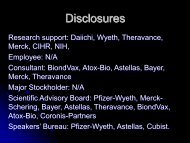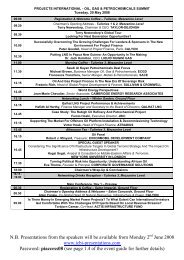Kieran Hand.pdf
Kieran Hand.pdf
Kieran Hand.pdf
You also want an ePaper? Increase the reach of your titles
YUMPU automatically turns print PDFs into web optimized ePapers that Google loves.
The rise of the antimicrobial<br />
pharmacist<br />
Dr <strong>Kieran</strong> <strong>Hand</strong><br />
Consultant Pharmacist Anti‐infectives<br />
BSAC Spring Meeting 23 rd March 2011
Destiny?<br />
c 1885
21 st Century Hospital Pharmacy<br />
£100-200k cost<br />
avoidance per week<br />
36% required<br />
intervention<br />
69% clarify or<br />
correct allergy<br />
47% incorrect<br />
30% errors on<br />
reconciliation<br />
994 interventions per week<br />
20 “potentially lethal”
Increasing collaboration with medical<br />
colleagues<br />
• “We propose that every<br />
clinical team, in primary<br />
and secondary care,<br />
should routinely include<br />
a named pharmacist.<br />
”<br />
Royal College of Physicians February<br />
2009
A potted history<br />
• The Worshipful Society of Apothecaries<br />
(founded 1617)<br />
• The Royal Pharmaceutical Society of Great<br />
Britain<br />
• 17 th Century – conflict between physicians i and<br />
apothecaries<br />
• 1704 The Rose test case – apothecaries evolved<br />
into general practitioners of medicine<br />
• 1815 The Apothecaries Act<br />
• 19 th Century – conflict between apothecaries<br />
and chemists and druggists<br />
• 1841 Founding of the Pharmaceutical Society of<br />
Great Britain (1843 Royal Charter of<br />
Incorporation)<br />
• 1852 The Pharmacy At Act – Register of<br />
Pharmaceutical Chemists<br />
• 1924 Bachelor of Pharmacy degree at<br />
University of London<br />
• 1933 The Pharmacy & Poisons Act –<br />
registration compulsory
Full circle: Pharmacist prescribing
Consultant Pharmacists<br />
DH March 2005
Microbiology, Infectious Diseases and Pharmacy<br />
in the UK:<br />
a history of collaboration<br />
• BSAC Working Party Report: Hospital antibiotic control<br />
measures in the UK (JAC 1994: 34; 21‐42)<br />
– “The potential for an expanded clinical role of the pharmacists should,<br />
in our opinion, be examined in this country.<br />
”<br />
• 2006 –Pharmacists in BSAC workshops<br />
• European Surveillance of Antimicrobial Consumption project<br />
• 2006 –Prof Jonathan Cooke is the first pharmacist to be<br />
appointed to BSAC Council<br />
• 2011 –Dr Conor Jamieson appointed BSAC Honorary<br />
Treasurer elect
Horses for courses
CID 1998
Why can’t we all just get along?
• Core members of a multidisciplinary antimicrobial stewardship team include<br />
an infectious diseases physician and a clinical pharmacist with infectious<br />
diseases training (A‐II), with the inclusion of a clinical microbiologist, an<br />
information system specialist, an infection control professional, and hospital<br />
epidemiologist being optimal (A‐III).<br />
CID January 2007
A National Network for Infection Pharmacists –In the<br />
beginning there was Wendy…<br />
Contacted 100 UK<br />
hospitals<br />
85 hospitals had<br />
no ID pharmacist<br />
15 hospitals had<br />
ID +/‐ HIV<br />
pharmacist<br />
5 hospitals had ID<br />
pharmacist (1 at<br />
Hammersmith)<br />
All were interested<br />
in the<br />
establishment of a<br />
national network<br />
Lawson W et al. J Infect 2000;40:A31
Establishment of a National Group: UK<br />
Clinical Pharmacy Association<br />
Local Support at Hammersmith Hospital 1999<br />
Ann Jacklin, Bryony Dean, Alison Holmes<br />
National Support Support 2001<br />
UKCPA General Committee, Alison Ewing, DoH –Keith Ridge Pharmacy & Prescribing branch<br />
and Interdepartmental Steering Group on Antimicrobial Resistance<br />
UKCPA 2002<br />
I wrote Wendy a submission Lawson: to UKCPA general committee which was accepted
UKCPA Electronic Message Boards<br />
Citi Critical lC Care<br />
• 474 members subscribed<br />
Surgery & Theatres<br />
• 454<br />
Infection Management<br />
Cardiology<br />
Emergency Care<br />
Respiratory<br />
• 422*<br />
• 331<br />
• 243<br />
• 235<br />
*Not all antimicrobial pharmacists
Integration into the Federation of<br />
Infection Societies (2009)
The Hospital Pharmacy Initiative<br />
£12M pump-prime funding<br />
Available 2003-06<br />
Non-recurring<br />
125/183 responses<br />
63% employed new staff<br />
23% expanded current roles<br />
106 pharmacy posts created<br />
50 on fixed-term contracts
Training of Specialist Pharmacists<br />
(2003)<br />
Course changing to residential blocks
Legislative mandate<br />
Health Act 2006<br />
• Abx policy in place<br />
approved by D&T<br />
• Audit program to show<br />
policies implemented<br />
• Rx harmonised with BNF<br />
• Procedures in place to<br />
ensure prudent prescribing.
•“An expert antimicrobial group (EAG) should be<br />
established to address effective and safe<br />
antimicrobial use.”<br />
• “The group should consist of specialist pharmacists,<br />
microbiologists, infection‐control nurses and medical<br />
staff as appropriate.”<br />
p
HPA / DH endorsement of pharmacists<br />
December 2008<br />
• Antimicrobial management<br />
team:<br />
–Micro/ID doctor<br />
–Pharmacist<br />
–IT analyst<br />
• Prescribing audits<br />
– Monthly feedback to wards<br />
• Mandatory training
Why appoint an antibiotic pharmacist?<br />
•Share the burden / blame / credit?<br />
•Abx consumption o surveillance<br />
• Guideline implementation<br />
• Audit and research<br />
• Education<br />
• Formulary management<br />
• Liaison with ward clinical pharmacists
Pharmacists as “eyes and ears” on the wards<br />
• Relatively stable staffing cf. junior<br />
doctors<br />
• Checking allergy, dosing,<br />
interactions<br />
• Surveillance and audit of ward<br />
prescribing<br />
• Enforcing formulary restrictions<br />
• Implementing guidelines, policy<br />
and training<br />
• Supporting micro/ID ward rounds<br />
• Monitoring for efficacy and side<br />
effects<br />
• Promoting streamlining and deescalation<br />
• Encouraging IV‐to‐oral switch<br />
• Integrated with specialist teams
Southampton electronic‐referral referral system<br />
Ward pharmacist identifies patient<br />
for microbiology ward round and<br />
generates electronic request<br />
Request received in microbiology<br />
and relevant laboratory results<br />
retrieved<br />
Audit &<br />
metrics<br />
Ward round recommendations<br />
communicated to doctors and<br />
pharmacists through results system<br />
Patient list printed and consultant<br />
medical microbiologist ward round<br />
takes place
The power of audit and feedback
Hospital guideline websites
Broad spectrum IV antibiotic use<br />
• Now reached a plateau, so looking at different strategies e.g. procalcitonin
Pocket Guide…..brought to you by the<br />
Microbiology and Pharmacy Departments….<br />
Trustwide Antimicrobial Use By Risk Classification<br />
(12 Month Rolling Average)<br />
70%<br />
60%<br />
50%<br />
40%<br />
30%<br />
20%<br />
10%<br />
0%<br />
Oct-06<br />
Nov-06<br />
Dec-06<br />
Jan-07<br />
Feb-07<br />
Mar-07<br />
Apr-07<br />
May-07<br />
Jun-07<br />
Jul-07<br />
Aug-07<br />
Sep-07<br />
Oct-07<br />
Nov-07<br />
Dec-07<br />
Jan-08<br />
Feb-08<br />
Mar-08<br />
Apr-08<br />
May-08<br />
Jun-08<br />
Jul-08<br />
Aug-08<br />
Sep-08<br />
Oct-08<br />
Nov-08<br />
Dec-08<br />
Jan-09<br />
Feb-09<br />
Mar-09<br />
Apr-09<br />
May-09<br />
Jun-09<br />
Jul-09<br />
Aug-09<br />
Sep-09<br />
Oct-09<br />
Nov-09<br />
Dec-09<br />
Jan-10<br />
Feb-10<br />
Mar-10<br />
Apr-10<br />
May-10<br />
Jun-10<br />
Jul-10<br />
Aug-10<br />
Sep-10<br />
Oct-10<br />
Antifungal Antiviral i High risk It Intermediate dit risk ik<br />
Low risk Specialist Ultra broad spectrum
70<br />
60<br />
50<br />
40<br />
30<br />
20<br />
10<br />
0<br />
SUHT Clostridium difficile rates<br />
SUHT Number of C.difficile Cases (>2 Years)<br />
Including SHA Trajectory<br />
64 63<br />
61 64 57 56<br />
46<br />
38 37<br />
34<br />
31<br />
29<br />
9<br />
38<br />
27 28<br />
25 25<br />
25 20 23 22 22<br />
19 18<br />
15<br />
13<br />
13 14<br />
11<br />
9 8 8 9 9 10 1114 11<br />
7 8<br />
5 5<br />
5 6 4<br />
No of Cases<br />
Apr-07<br />
May-<br />
Jun-07<br />
Jul-07<br />
Aug-07<br />
Sep-07<br />
Oct-07<br />
Nov-07<br />
Dec-07<br />
Jan-08<br />
Feb-08<br />
Mar-08<br />
Apr-08<br />
May-<br />
Jun-08<br />
Jul-08<br />
Aug-08<br />
Sep-08<br />
Oct-08<br />
Nov-08<br />
Dec-08<br />
Jan-09<br />
Feb-09<br />
Mar-09<br />
Apr-09<br />
May-<br />
Jun-09<br />
Jul-09<br />
Aug-09<br />
Sep-09<br />
Oct-09<br />
Nov-09<br />
Dec-09<br />
Jan-10<br />
Feb-10<br />
Mar-10<br />
Apr-10<br />
May-<br />
Jun-10<br />
Jul-10<br />
Aug-10<br />
Sep-10<br />
Oct-10<br />
Nov-10<br />
Dec-10<br />
SUHT SHA Trajectory Linear (SUHT)
14000<br />
Sum of Total DDD<br />
12000<br />
10000<br />
8000<br />
6000<br />
4000<br />
2000<br />
Drug Type<br />
Meropenem<br />
Imipenem and enzyme inhibit<br />
Ertapenem<br />
Carbapenem use<br />
SUHT 2005-20092009<br />
0<br />
1800<br />
2005 2006 2007 2008 2009<br />
Count of PATIENT NAME<br />
1600<br />
1400<br />
1200<br />
1000<br />
Imipenem I/R isolates<br />
800 SUHT 2005-20092009<br />
600<br />
400<br />
200<br />
0<br />
2005 2006 2007 2008 2009
• All‐Wales Wl co‐ordination i of<br />
microbiologists and pharmacists<br />
in secondary care<br />
• Point prevalence survey 2009<br />
• Antibiotic consumption trend<br />
data for 2005‐2010<br />
• Antibiotic resistance trend data<br />
2005‐2009<br />
• Co‐ordinated and analysed by<br />
Maggie Heginbothom and Robin<br />
Howe
Scottish Medicines Consortium<br />
Scot MARAP & SAPG<br />
• Scottish Management of Antimicrobial Resistance<br />
Action Plan issued in March 2008.<br />
• Made recommendations to ensure prudent use of<br />
antimicrobials.<br />
• Scottish Antimicrobial Prescribing Group (SAPG)<br />
formed to lead and coordinate national delivery of<br />
ScotMARAP – hosted by SMC and funded by<br />
Scottish Government.<br />
• SAPG has same collaborative structure as SMC<br />
i.e. representatives from key national and local<br />
stakeholders
Mark Gilchrist leading on UK OPAT registry project
Antibiotic pharmacists in Primary Care
The next steps: embracing technology
The future? Electronic Rx?<br />
Computer says ‘No’
Acknowledgments<br />
•Dr Berge Azadian, Pippa Roberts, Chelsea &<br />
Westminster<br />
• Wendy Lawson, Prof Ann Jacklin, Prof Alison Holmes,<br />
Hammersmith<br />
•Dr Hayley y Wickens, St. Mary’s<br />
•Mark Gilchrist, Charing Cross<br />
• Philip Howard, Leeds<br />
•Paul Wade, Guy’s and St. Thomas’<br />
• Prof Jonathan Cooke, South Manchester<br />
•Dr Conor Jamieson, Birmingham<br />
• BSAC: Prof fPt Peter Davey, Tracey Guise, Prof fRoger<br />
Finch, Prof Richard Wise
synergy ●n. interaction or cooperation<br />
of two or more organisations, substances<br />
or other agents to produce a combined<br />
effect greater than the sum of their<br />
separate effects.








